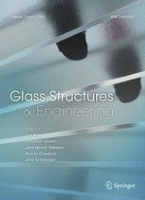
Glass Structures & Engineering
Scope & Guideline
Innovating the Future of Architectural Glass.
Introduction
Aims and Scopes
- Structural Performance and Analysis:
The journal emphasizes understanding the mechanical performance of glass in various structural applications, including load-bearing capacity, fracture mechanics, and stress analysis under different loading conditions. - Innovative Glass Technologies:
Research on advanced technologies such as additive manufacturing, laminated glass, and smart glass solutions is a core focus, highlighting new methods that enhance the functionality of glass in architectural applications. - Sustainability and Circular Economy:
The journal promotes studies on the reuse, recycling, and remanufacturing of glass products, addressing the environmental impact of glass in construction and advocating for sustainable practices. - Design and Optimization Techniques:
Papers often explore computational design methods, optimization strategies, and simulation techniques that enhance the structural integrity and aesthetic appeal of glass structures. - Experimental and Numerical Investigations:
A significant component of the journal's focus is on empirical studies and numerical simulations that validate theoretical models and provide insights into the behavior of glass under various conditions.
Trending and Emerging
- Human-Centered Design in Glass Applications:
Recent studies emphasize the importance of human factors in the design and performance of glass structures, reflecting a growing interest in user experience and safety. - Advanced Computational Methods and Simulation:
There is an increasing trend towards utilizing advanced computational techniques, such as finite element analysis and machine learning, to predict and optimize the performance of glass structures. - Seismic and Blast Resistance of Glass Structures:
Research focused on the resilience of glass structures to extreme events like blasts and earthquakes is on the rise, highlighting the need for safety in architectural design. - Sustainable Practices in Glass Use:
Emerging themes include the exploration of glass recycling, remanufacturing, and circular economy principles, addressing the environmental impact of glass in construction. - Integration of Smart Technologies in Glass Design:
The integration of smart technologies and materials in glass applications is gaining popularity, reflecting the trend towards intelligent building systems that enhance energy efficiency and functionality.
Declining or Waning
- Traditional Glass Manufacturing Processes:
Research focused on conventional glass manufacturing techniques has diminished as the field shifts towards innovative and sustainable practices such as recycling and additive manufacturing. - Basic Glass Properties without Structural Context:
Papers concentrating solely on the fundamental properties of glass without their application in structural contexts are appearing less frequently, as the journal increasingly emphasizes practical applications in engineering. - Historical Glass Studies:
There has been a noticeable reduction in studies focused purely on historical glass artifacts or architectural history, with a greater emphasis now on contemporary applications and innovations. - Non-Engineering Related Glass Applications:
Research that does not directly relate to engineering or structural applications of glass, such as purely aesthetic studies, is declining as the journal continues to focus on practical engineering solutions.
Similar Journals
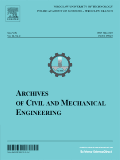
Archives of Civil and Mechanical Engineering
Fostering Knowledge in Civil and Mechanical DisciplinesArchives of Civil and Mechanical Engineering is a distinguished peer-reviewed journal published by SpringerNature, focusing on advancing the fields of civil and mechanical engineering. With an impressive Q1 ranking in both categories in 2023, this journal caters to a global audience, addressing the evolving challenges and innovations within these vital engineering disciplines. The journal has been a pivotal platform since its inception in 2006, and it continues to be essential for researchers and practitioners seeking to publish and access high-quality research. The absence of an Open Access option ensures that published works maintain rigorous academic standards, thereby enhancing their value within institutional repositories. With a robust impact factor and high visibility on Scopus—ranking #122 out of 672 in Mechanical Engineering and #74 out of 379 in Civil and Structural Engineering—this journal is an ideal venue for professionals, researchers, and students dedicated to advancing their knowledge and contributing to cutting-edge engineering practices. Based in Germany and operating internationally, the Archives of Civil and Mechanical Engineering invites submissions that address critical issues and solutions in contemporary engineering.
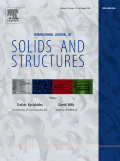
INTERNATIONAL JOURNAL OF SOLIDS AND STRUCTURES
Pioneering Research in Solids and StructuresINTERNATIONAL JOURNAL OF SOLIDS AND STRUCTURES, published by PERGAMON-ELSEVIER SCIENCE LTD, is a leading academic journal with a strong reputation in the fields of engineering and applied mathematics. Established in 1965 and converging its impact on research through 2024, this journal is highly regarded within Q1 quartile rankings across multiple disciplines, including Applied Mathematics, Condensed Matter Physics, and Mechanical Engineering. With its ISSN 0020-7683 and E-ISSN 1879-2146, the journal is systematically indexed and accessible to a global audience, although it does not currently offer open access options. Researchers, professionals, and students alike benefit from its high-impact research articles, as evidenced by its impressive Scopus rankings in various categories, including a 91st percentile in Applied Mathematics and 81st in Mechanical Engineering. The journal serves as a critical platform for the dissemination of groundbreaking findings in solid and structural mechanics, promoting innovation and collaboration within the scientific community.

STRENGTH OF MATERIALS
Pioneering research in the strength of materials since 1969.STRENGTH OF MATERIALS is a prestigious journal published by SPRINGER that focuses on the critical field of mechanics of materials, providing an authoritative platform for the dissemination of research and developments in material strength analysis since 1969. With an ISSN of 0039-2316 and an E-ISSN of 1573-9325, this journal serves a global audience of researchers, professionals, and students, contributing essential insights into the physical properties and performance characteristics of various materials under stress and strain. As part of the United States' academic literature, it showcases work that not only advances theoretical knowledge but also applies to practical engineering scenarios. Although ranked in the Q4 tier with respect to its category in Mechanics of Materials, with a Scopus rank of #319 out of 398 (19th percentile), it remains an important resource for those looking to expand their understanding in this specialized area. Researchers can access a wealth of information through this journal, fostering continued innovation and interdisciplinary collaboration.

World Journal of Engineering
Exploring New Frontiers in Engineering ResearchWorld Journal of Engineering, published by EMERALD GROUP PUBLISHING LTD, stands as a premier platform for disseminating high-quality research across various engineering disciplines. Since its inception in 2014, the journal has built a reputation for its rigorous peer-review process and commitment to advancing knowledge in the fields of Civil and Structural Engineering, Electrical and Electronic Engineering, Geotechnical Engineering, Mechanical Engineering, and Mechanics of Materials. With its categorization in the Q3 quartile across multiple engineering domains and notable Scopus rankings, the journal positions itself as a valuable resource for researchers, professionals, and students seeking to stay abreast of innovations and critical developments in engineering. While the journal currently operates under a subscription model, its comprehensive scope ensures that it remains a vital reference point for contemporary engineering challenges and solutions throughout the United Kingdom and beyond.

Journal of Materials and Engineering Structures
Innovating the Future of Materials ScienceJournal of Materials and Engineering Structures is a pioneering Open Access journal published by MOULOUD MAMMERI UNIVERSITY OF TIZI-OUZOU, dedicated to advancing the field of materials science and engineering. Since its inception in 2014, the journal has aimed to provide researchers, professionals, and students with a platform for sharing cutting-edge research and innovative applications in materials engineering and construction structures. Although the HIndex and Scopus ranking data are not specified, the journal plays a crucial role in disseminating knowledge that contributes to the development of sustainable and efficient engineering practices. With its commitment to accessibility and knowledge sharing in the heart of Algeria, the Journal of Materials and Engineering Structures is poised to make a significant impact on both local and global academic communities.
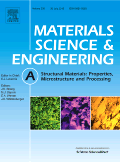
MATERIALS SCIENCE AND ENGINEERING A-STRUCTURAL MATERIALS PROPERTIES MICROSTRUCTURE AND PROCESSING
Bridging Theory and Application in Structural MaterialsMATERIALS SCIENCE AND ENGINEERING A-STRUCTURAL MATERIALS PROPERTIES MICROSTRUCTURE AND PROCESSING, published by ELSEVIER SCIENCE SA, is a highly regarded journal specializing in the fundamental and applied aspects of materials science. Since its inception in 1988, this journal has established itself as a leading platform for disseminating innovative research findings, particularly focused on structural materials, their properties, microstructure, and processing techniques. With a prominent impact in the field, it ranks in the Q1 category across several disciplines including Condensed Matter Physics, Materials Science, Mechanical Engineering, and Nanoscience and Nanotechnology, highlighting its significance and influence within the academic community. The journal is accessible to a global audience of researchers, professionals, and students, underscoring its commitment to advancing knowledge in materials engineering. Aspiring authors and readers will find this journal an essential resource for cutting-edge research and the latest advancements in the field, further supported by its impressive Scopus rankings that place it among the top-tier publications.
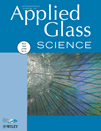
International Journal of Applied Glass Science
Shaping the Landscape of Glass Technology ResearchThe International Journal of Applied Glass Science, published by Wiley Periodicals, Inc, is a leading scholarly journal in the field of materials science, particularly focusing on the applications and innovations in glass science. Since its inception in 2010, the journal has served as a vital platform for disseminating high-quality research and advancing knowledge within the community, maintaining a respectable Q2 ranking in the Materials Science (Miscellaneous) category as of 2023. With an ISSN of 2041-1286 and E-ISSN of 2041-1294, it continues to attract a diverse array of manuscripts that explore fundamental and applied aspects of glass technology and its countless applications. Scholars and professionals benefit from the journal’s commitment to transparency and accessibility, even in the absence of an open access model, thereby reinforcing its relevance in an evolving academic landscape. The journal is positioned to be an influential resource for researchers, professionals, and students keen to stay at the forefront of glass science developments.

Magazine of Civil Engineering
Innovative Insights into Civil and Structural EngineeringMagazine of Civil Engineering, published by ST-PETERSBURG STATE POLYTECHNICAL UNIVERSITY, is a prominent open access journal dedicated to the field of civil and structural engineering. With an ISSN of 2712-8172 and E-ISSN 2071-0305, it serves as a vital platform for disseminating high-quality research, innovative methodologies, and current trends in building and construction. Since its inception in 2010, the journal has embraced open access, ensuring broad visibility and accessibility for its contributions to the academic community. The magazine holds a respectable position in the academic hierarchy, ranked in the Q3 quartile for both Building and Construction and Civil and Structural Engineering categories as of 2023. It is indexed in Scopus, amplifying its societal impact and reach with a rank of #114/223 in Building and Construction and #224/379 in Civil and Structural Engineering. Researchers, professionals, and students alike are encouraged to engage with the cutting-edge studies presented in the magazine, contributing to the advancement of knowledge and practice within the civil engineering domain.

Electronic Journal of Structural Engineering
Innovative Insights for Modern Engineering ChallengesThe Electronic Journal of Structural Engineering (ISSN: 1443-9255), published by EJSE INT LTD, serves as a vital platform for disseminating innovative research and developments in the field of structural engineering. Since its inception in 2001, the journal has evolved to embrace an Open Access model starting in 2022, ensuring that cutting-edge findings are freely accessible to researchers, professionals, and students worldwide. Housed within the reputable Department of Infrastructure Engineering at the University of Melbourne, Australia, the journal focuses on a wide range of topics related to civil and structural engineering, positioning itself within the Q4 category on the 2023 Scopus rankings. While its H-index and detailed scope data are currently unavailable, the journal's commitment to quality research is evident through its continuous publication and engagement with the global academic community. With significant implications for contemporary engineering practices, The Electronic Journal of Structural Engineering not only fosters scholarly discourse but also encourages practical applications of structural engineering advancements.

GLASS AND CERAMICS
Exploring the Boundaries of Glass and Ceramics ResearchGLASS AND CERAMICS is a premier academic journal published by Springer, focusing on the vital fields of ceramics and composites, materials chemistry, and the mechanics of materials. Since its inception in 1956, this journal has contributed significantly to the advancement of knowledge and innovation in these domains, with a commendable 2023 Q3 quartile ranking in its categories. With an ISSN of 0361-7610 and an E-ISSN of 1573-8515, GLASS AND CERAMICS provides a platform for rigorous research and scholarly discussion, catering to a diverse audience of researchers, professionals, and students. Although the journal does not currently offer open access, it continues to disseminate vital insights that drive advancements in the materials science community. The journal’s commitment to high-quality research is underscored by its long-standing publication history and relevance in shaping future materials technology.